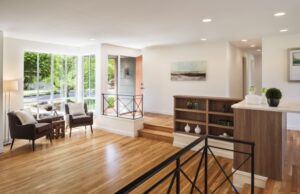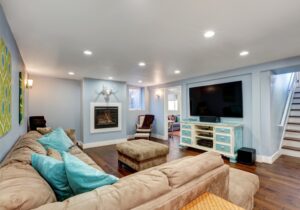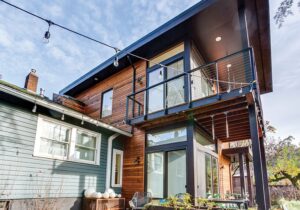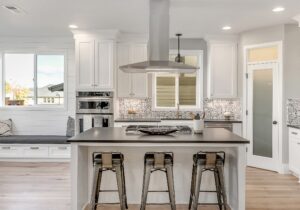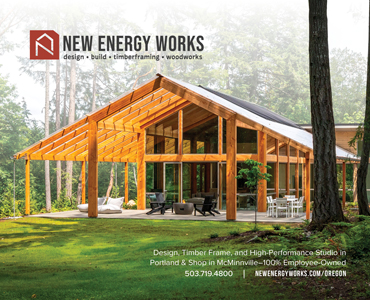[1. IF YOU’RE AN ART COLLECTOR, OPT FOR BUILT-IN OR FLUSH-MOUNT SPEAKERS.]
You want that amazing Jackson Pollock you inherited from your grandmother to be the focal point of your living room, not those large, clunky speakers you’ve had since high school that you’ve kept for sentimental reasons. “These days, it’s really easy to make speakers disappear, so there’s almost no reason to have them visible,” says Chris Rasmussen, the owner of Hear No Evil in Salem, Ore. “Speakers can be installed in walls or ceilings and painted or integrated into a bookcase. There are also a lot of different speaker shapes, and finishes that range from real wood to high-gloss, so it’s easy to have your audio system work with your room’s décor.”
[2. ZONE OUT, BUT N A GOOD WAY.]
If you, your spouse and your kids have different opinions about which musician should be belting out tunes in your house, set up multiple listening zones, which allow everyone to listen to what he or she wants when he or she wants. “Just spend some time thinking through how you set up your zones,” says Rasmussen. “Bedrooms are usually their own zones, but be careful in spaces that connect to each other. If your living room, dining room and kitchen open up to each other, make that one zone since you’ll hear what’s being played in one area if you’re sitting in another.”
[3. WHEN YOU REMODEL, ADD WIRING FOR AUDIO—AND OTHER—SYSTEMS.]
If you’re in the middle of a home improvement project that involves opening or building walls (or building a custom home), wire your home for a state-of-the-art audio system. “For a small amount of money, you can hard-wire speakers to various rooms as well as locate amplifiers near your sound and media system,” says Kurt Doslu, the owner of Echo Audio in Portland. “There are speakers such as solid drive speakers, which are sound transducers, that can be installed behind drywall and make your speaker system invisible. You can also install Cat5 wires, which allow you to integrate cameras and security systems into a single system.”
[4. DON’T HESITATE TO CONSOLIDATE.]
A big advantage of wiring your home for a sound system is that it can simplify the technology for your whole house. “Today’s technology really makes it easier to integrate music, lights, an intercom and other control systems,” says Joe Ness, a system designer at Quadrant Systems in Portland. “It’s always better to have a central location for these things than to have them scattered throughout the house.”
[5. TAKE IT OUTSIDE!]
While you’re integrating your interior sound system, don’t forget about your outdoor living spaces. When you’re barbecuing or hanging out with friends on the patio, you’ll want music out there, too. “For the outdoors, you can tuck surface-mount speakers under the eaves and make that one of the zones in your sound system,” says Ness. “You’ll also need a portable speaker that works off your wireless. Soundcast makes a 38-inch-tall, 10-inch-wide speaker that works outdoors. It works wirelessly, so you can play your music lists on it. And since it’s portable, you can take it with you when you work in the yard or in the garage.” A Soundcast wireless outdoor speaker starts at around $800.
[6. BEFORE YOU CHOOSE GRADES OF SPEAKERS AND TYPES OF AMPLIFICATION FOR A ROOM, ASSESS HOW YOU TYPICALLY LISTEN TO SOUND IN THAT SPACE.]
Audio experts know that the way you listen to sound varies throughout the day. “You listen to sound in different ways depending on what you’re doing,” says Rasmussen. “If you’re having people over or working in your home office, you may have music on in the background. But you may also have a room in your house where you go to relax, and where you really listen to what you’re playing. How you listen and what you expect from your audio system determines which type of speakers and amplification systems I’d install in a specific space in your home.”
[7. BONE UP ON YOUR CONTROL OPTIONS.]
Figuring out how you’ll access your system begins with knowing exactly how many people will use your audio system. “If you live alone, you might just need a central control that turns on your system and then lets you adjust the volume in a room,” says Rasmussen. “But if you move around the house a lot, have different things you listen to at different times of the day or live with other people, a keypad or an individual-touch system in each room will allow for greater control and let you play different types of music in different areas of the home.”
[8. MASTER THE ART OF SPEAKER PLACEMENT.]
When piping sound into a room, place the speakers strategically. You may think you want a ceiling speaker over the center island in your kitchen, but you don’t. “Don’t locate speakers right over your head; place them in the corners of a room,” says Doslu. “If you place them about 18 inches out of a corner, the sound will bounce off the walls and be sent all around the room.”
[9. WHEN WIRING A GREAT ROOM FOR SOUND, THINK BEYOND THE TWO-SPEAKERS-PER-ROOM QUOTA.]
If you’ve got a sprawling Great Room, you’ll probably need more than two speakers in the room to have uniform sound quality throughout the space. “I generally suggest you use several small speakers rather than two large ones,” says Doslu. ‘That provides a better listening experience because as you walk around, the sound quality doesn’t fluctuate depending on where you’re standing.”
[10. DON’T DISCOUNT WIRELESS TECHNOLOGY.]
It’s now possible to install simple wireless systems that produce great sound throughout your house. “Companies such as Sonos and Logitech, which makes a product called the Squeezebox™ Touch, have developed systems to play music wirelessly throughout your house by accessing your music playlists on your computer and your phone,” says Doslu. “The systems are easy to install right out of the box.” A Sonos system starts at around $400.
[11. USE YOUR SMARTPHONE FOR MORE THAN CALLING, E-MAILING AND TEXTING.]
If you have a smartphone or a computer, you already have a way to control your audio system, allowing you to do everything from controlling the volume to selecting playlists and accessing music applications such as Rhapsody and Pandora. “Products such as the iPhone show that the demand for technology-related applications is enormous,” says Ness. “Applications can turn your smartphone into an interface device that lets you control the systems in your home without buying a special control device.”
[12. DON’T FORGET ABOUT YOUR MUSIC STORAGE NEEDS.]
While a dock in your audio system for an mp3 device will allow you to access music without having to clutter up your shelves with CDs, there are other alternatives to music storage. “Some systems allow you to centrally locate your CDs—as well as your DVDs—on hard drives,” says Rasmussen. “That gives you a higher quality of playback, and, in the case of movies and TV, if you have your screens linked to your central system, when you’re having a party, every screen in your house can show the same thing, whether it’s a movie or the Super Bowl.”
[13. LEAN INTO THE TRANSFORMATIVE POWER OF WHOLE-HOUSE SOUND.]
If you want to change the feel of your home, just add music. “A whole-house music system changes the vibe of your house,” says Ness. “It makes for a more pleasant living environment. It’s similar to when you visit a friend and as soon as you step into his or her house, you smell something amazing cooking. You can’t see it; you experience it and it totally transforms the feel of the house. Music is the same way. When I return to a home after we’ve installed a whole-house system, the owners always tell me how they wish they’d done it sooner because it’s transformed their experience of their own home.” n




